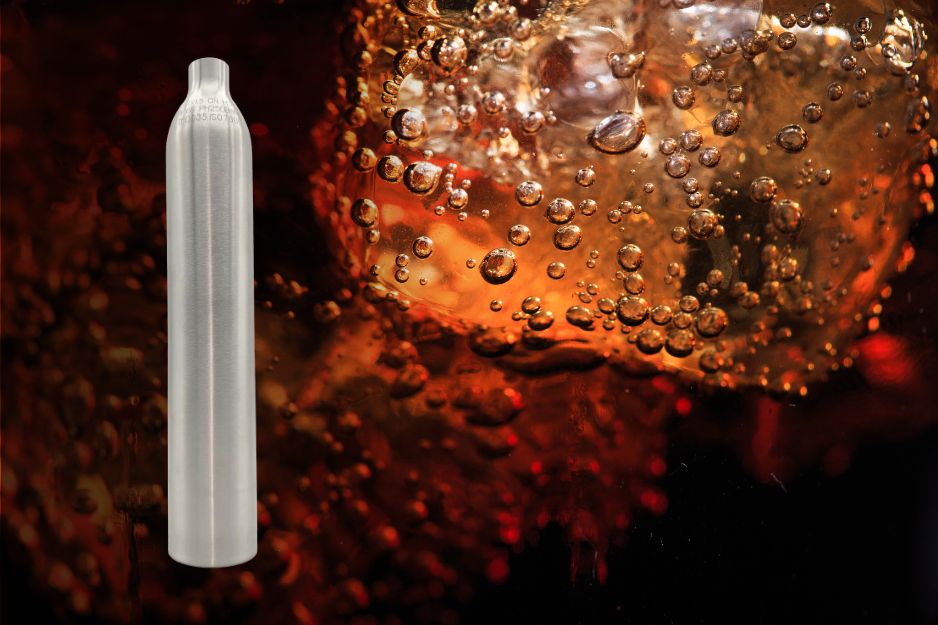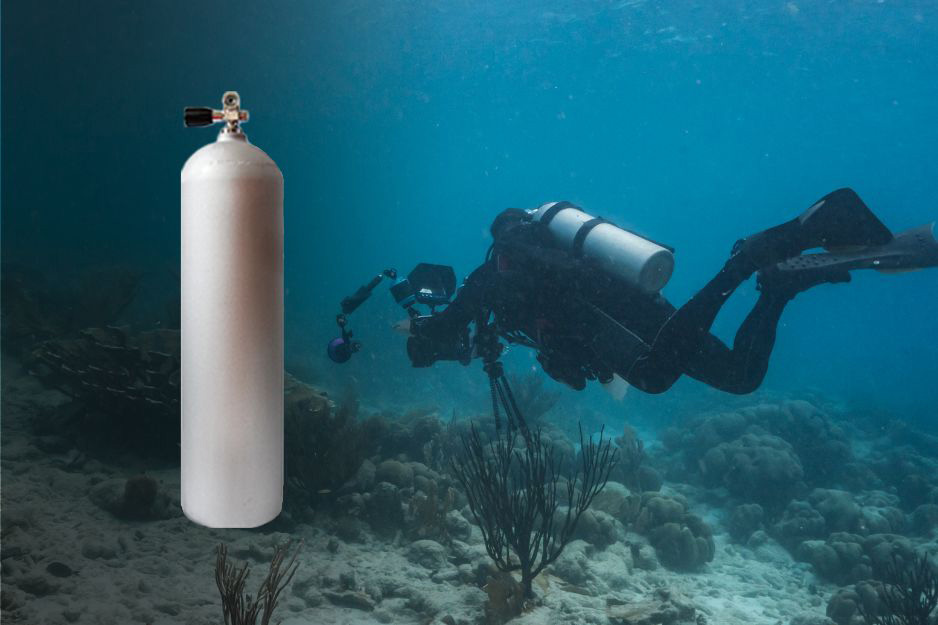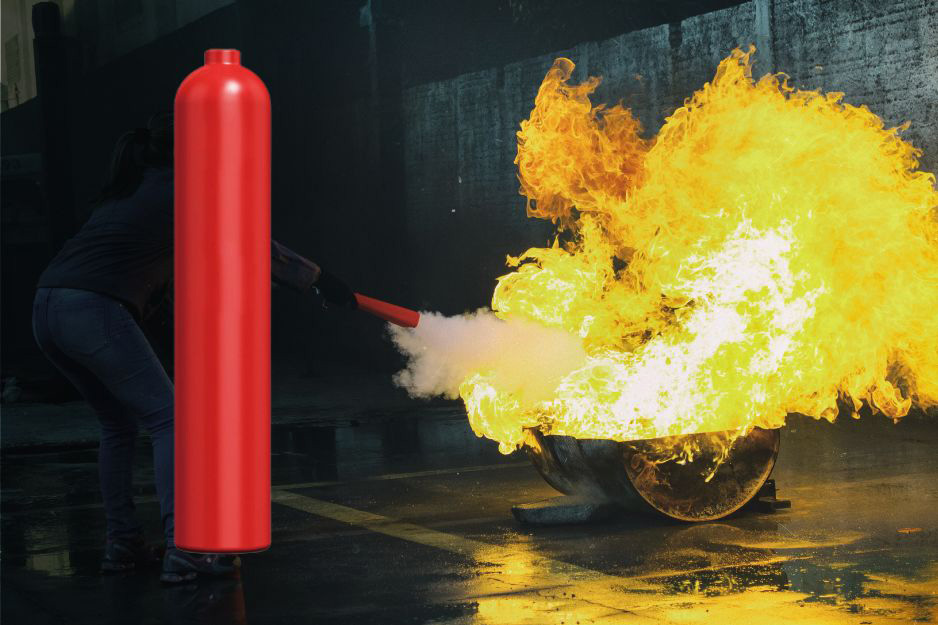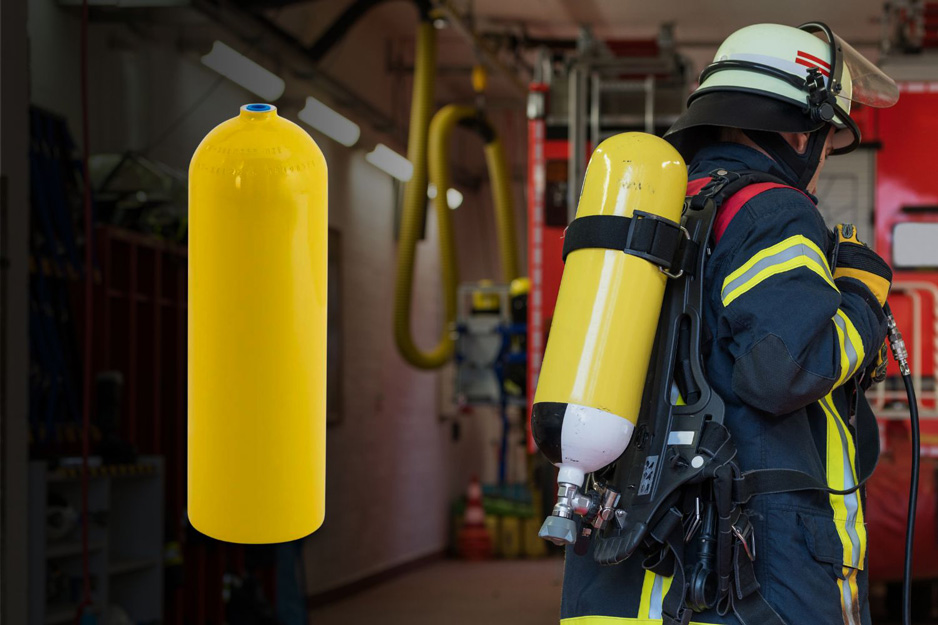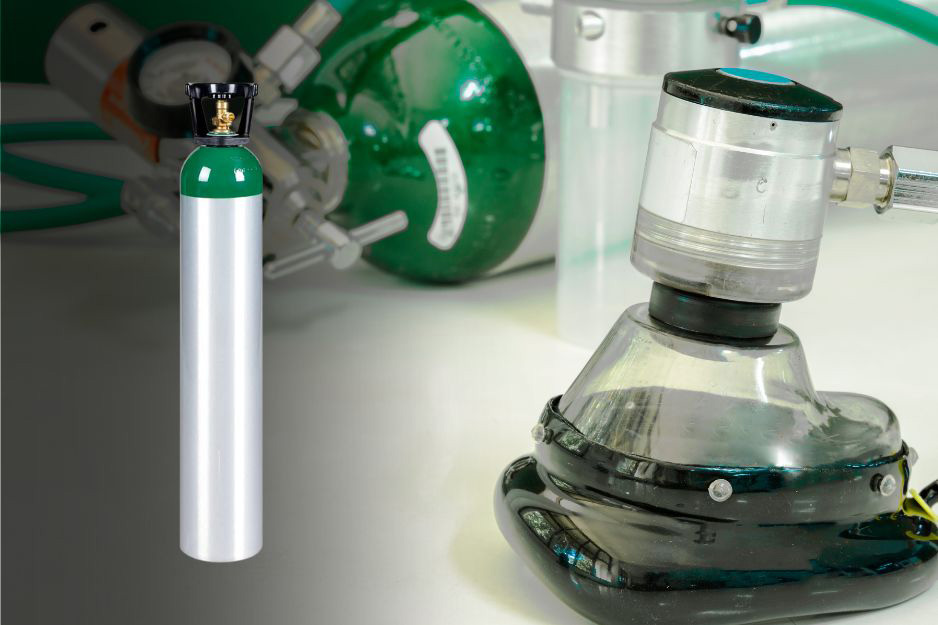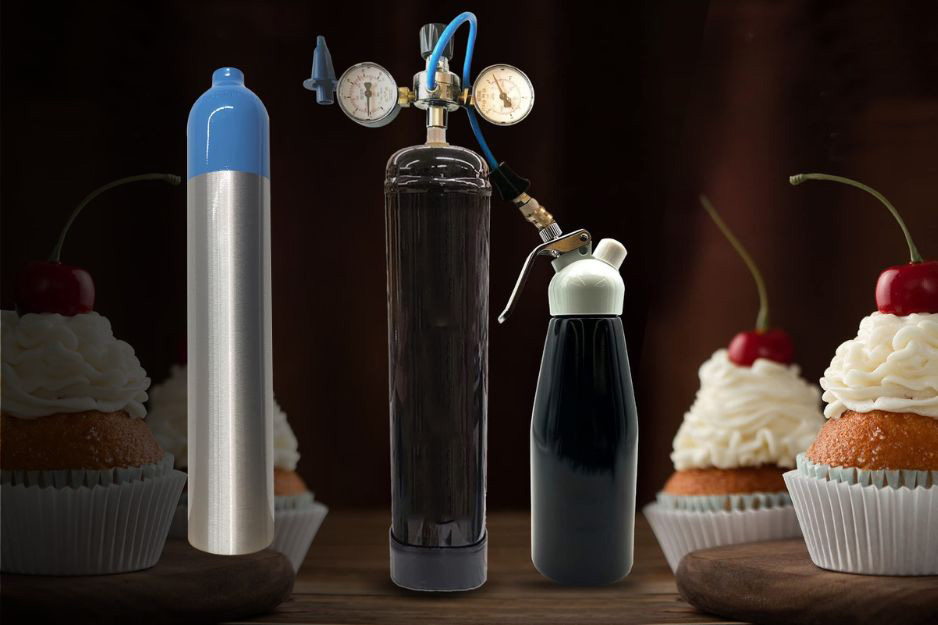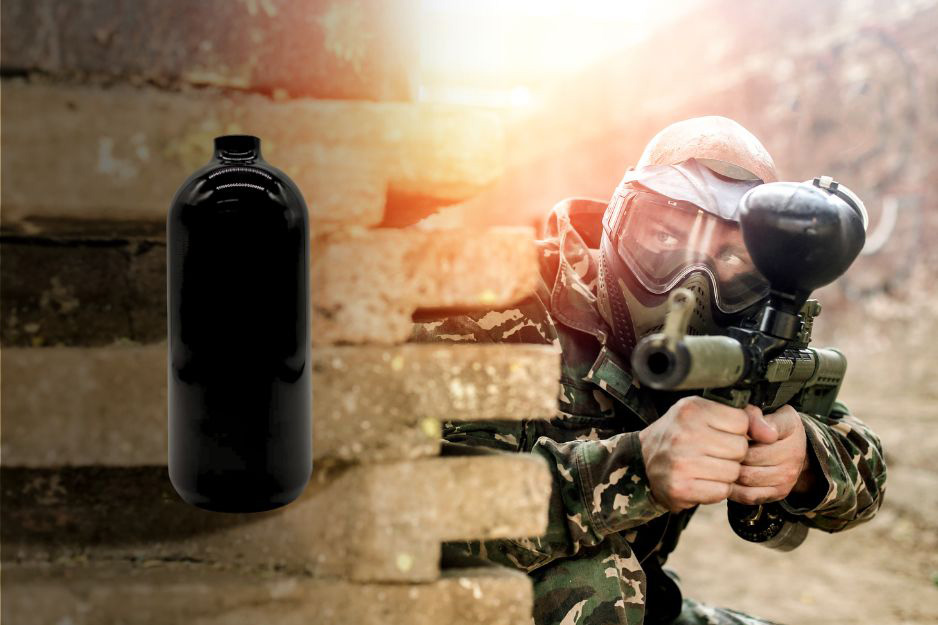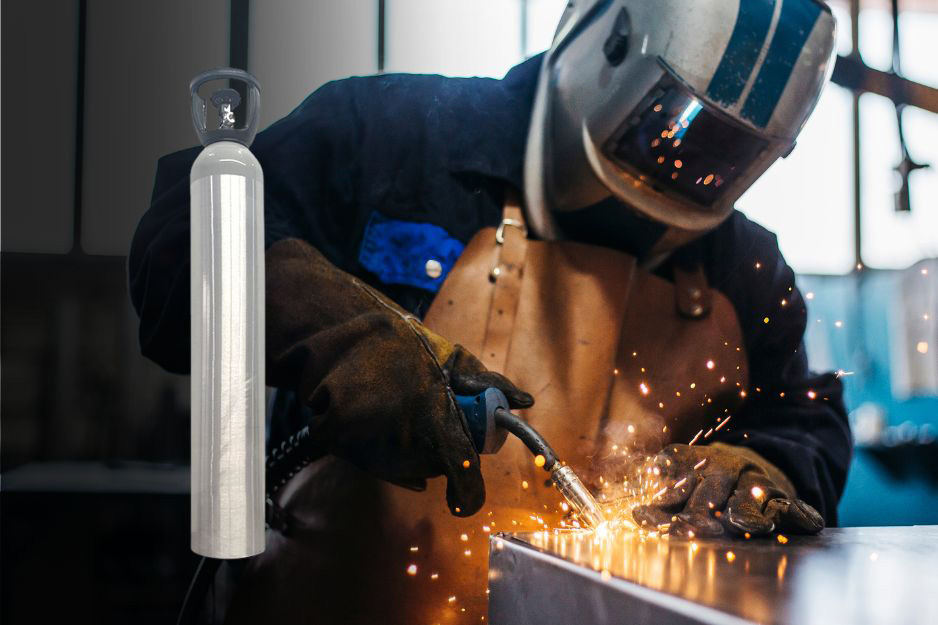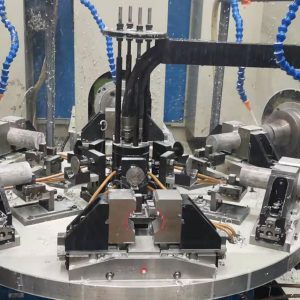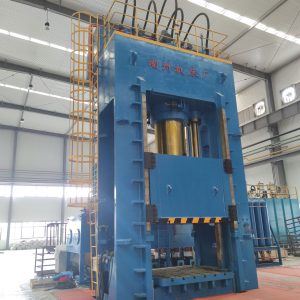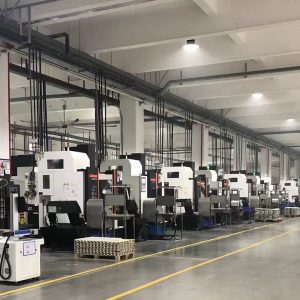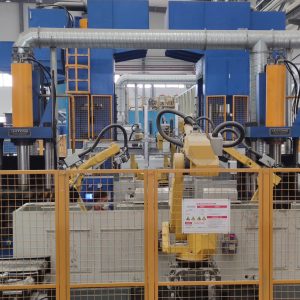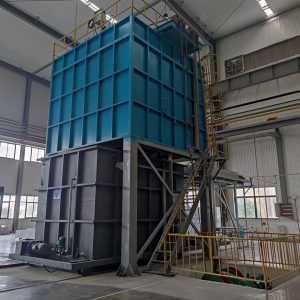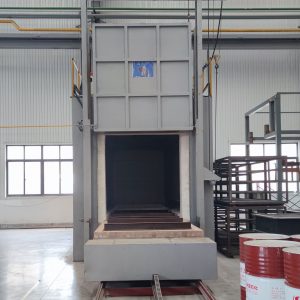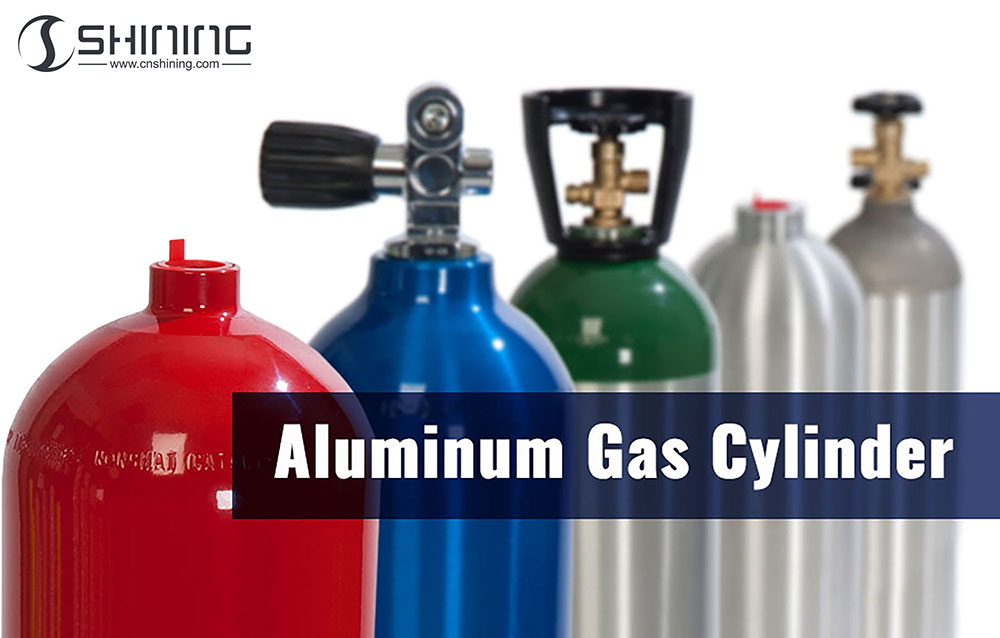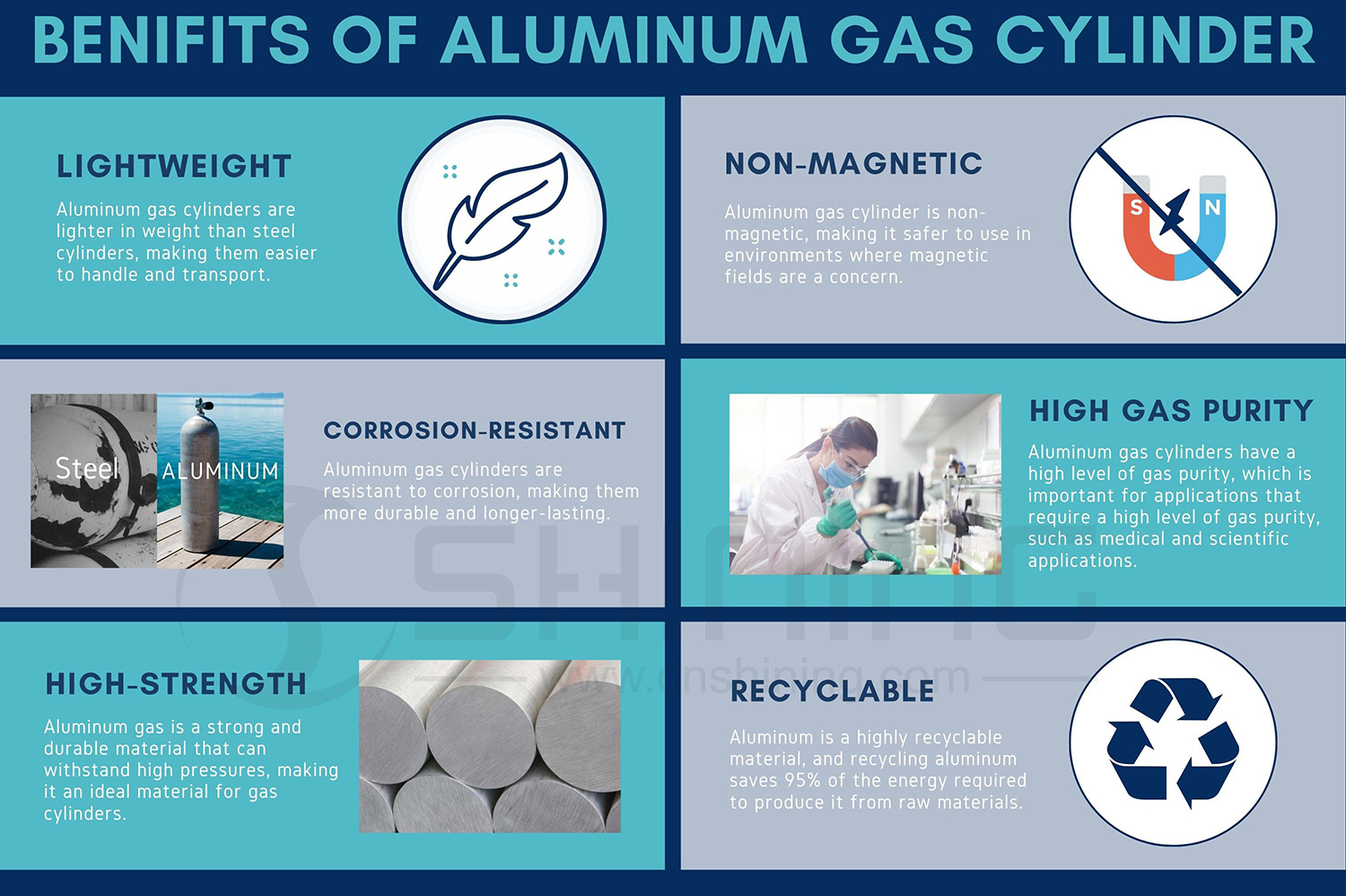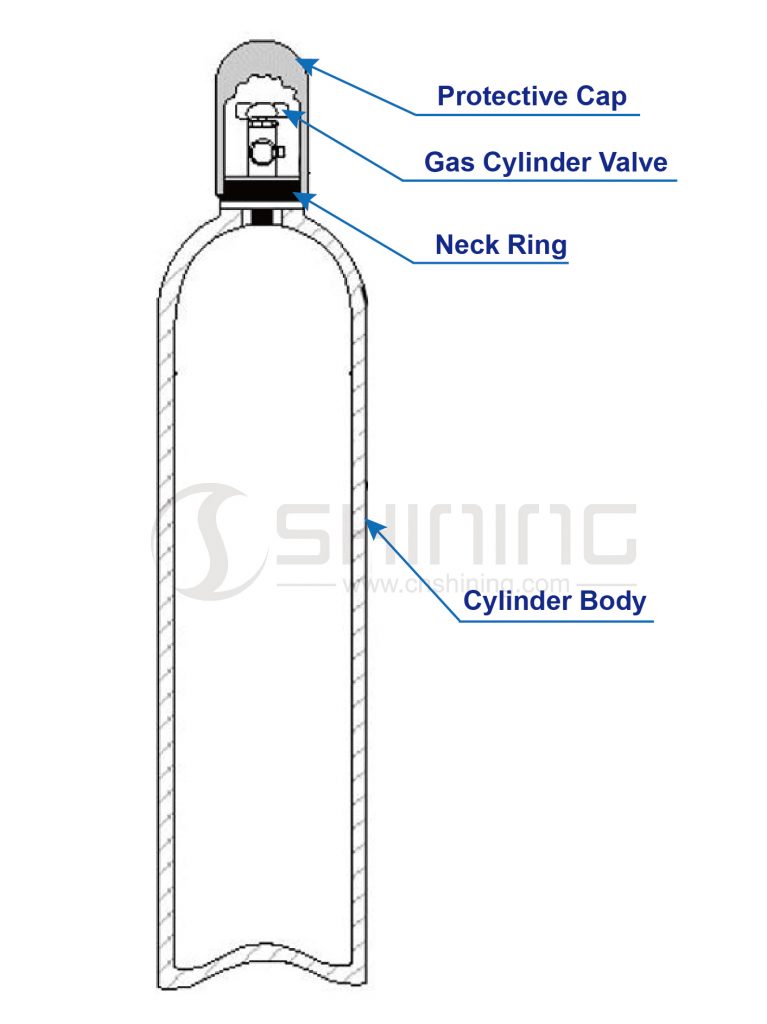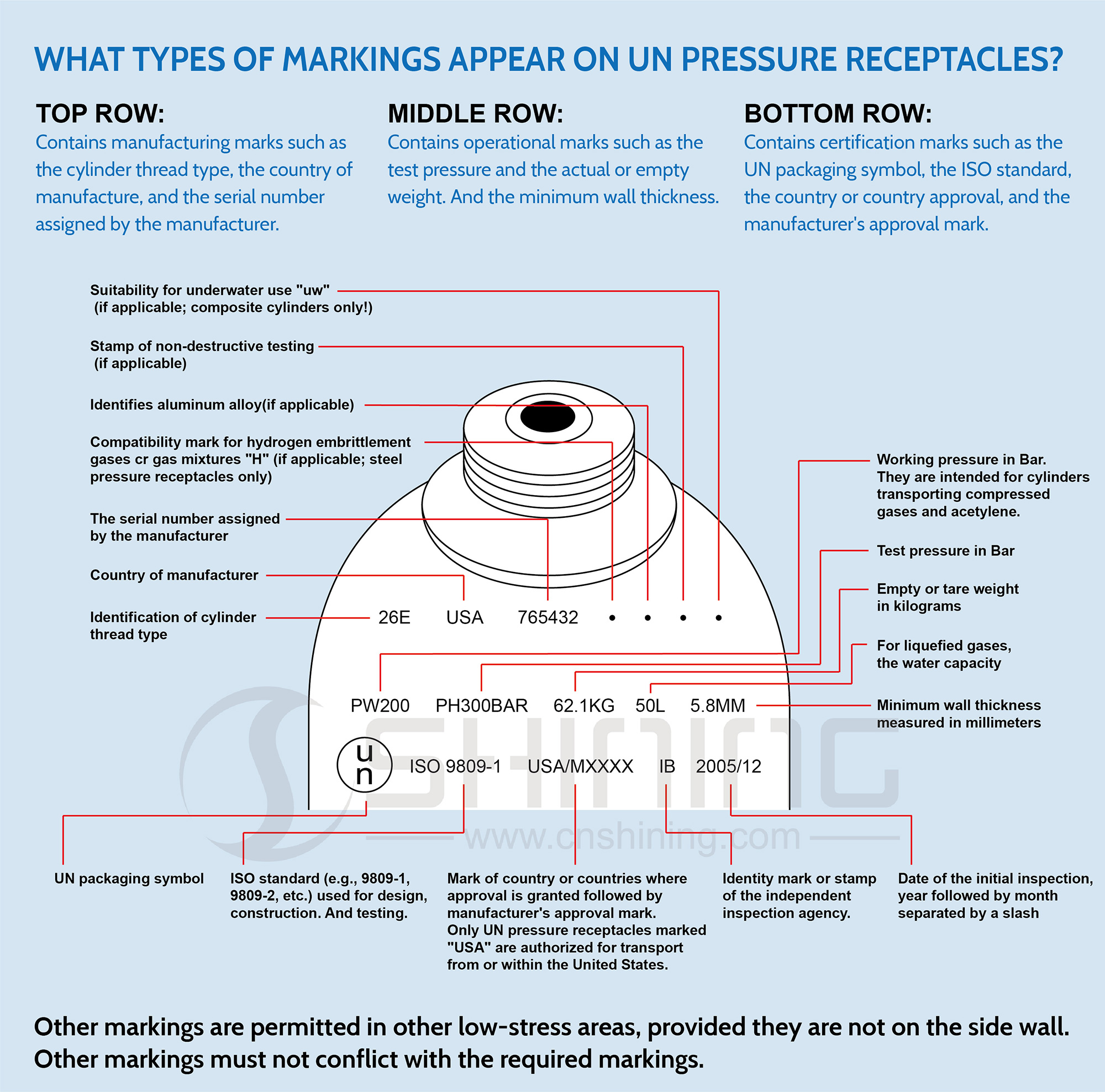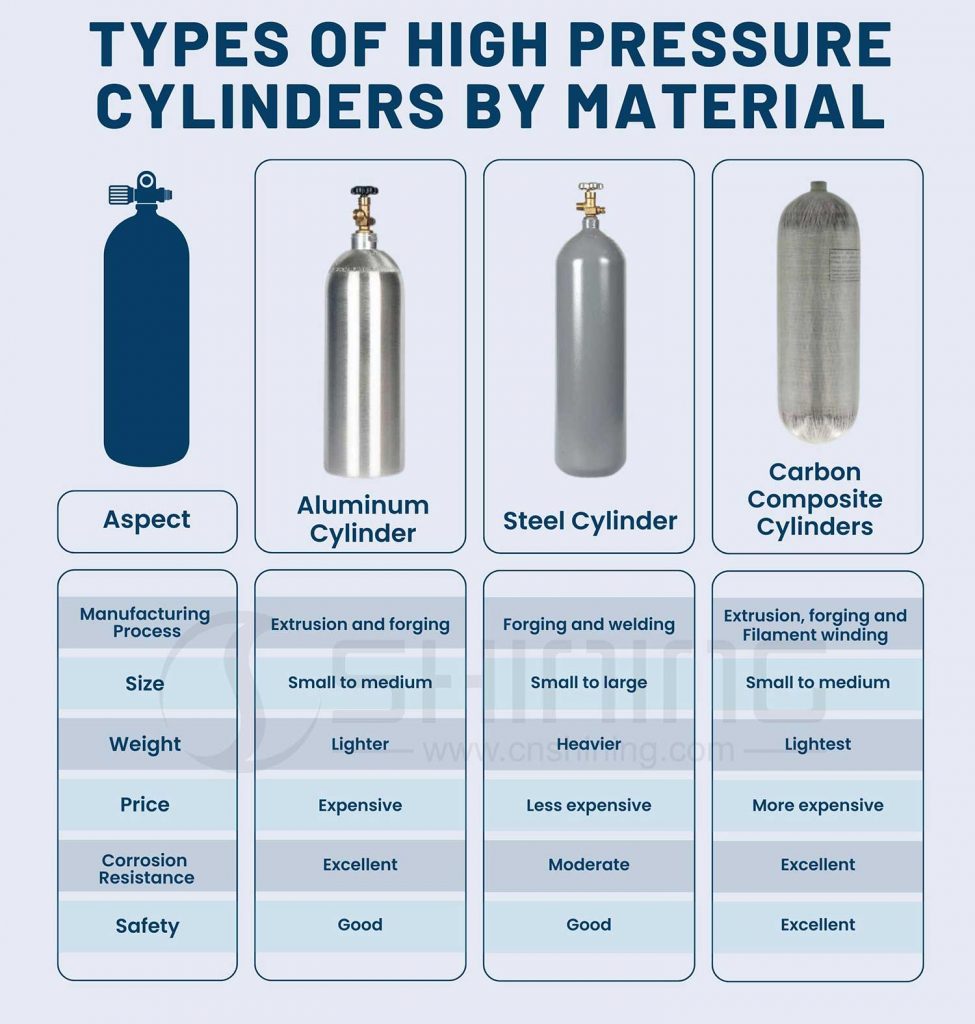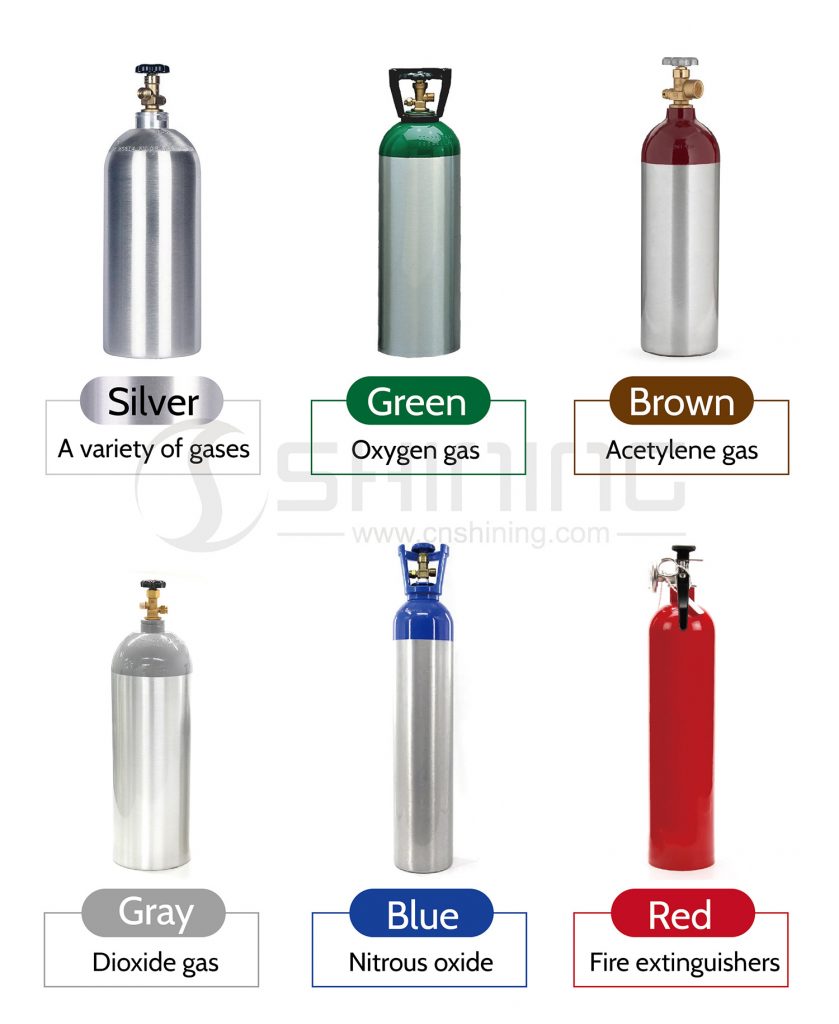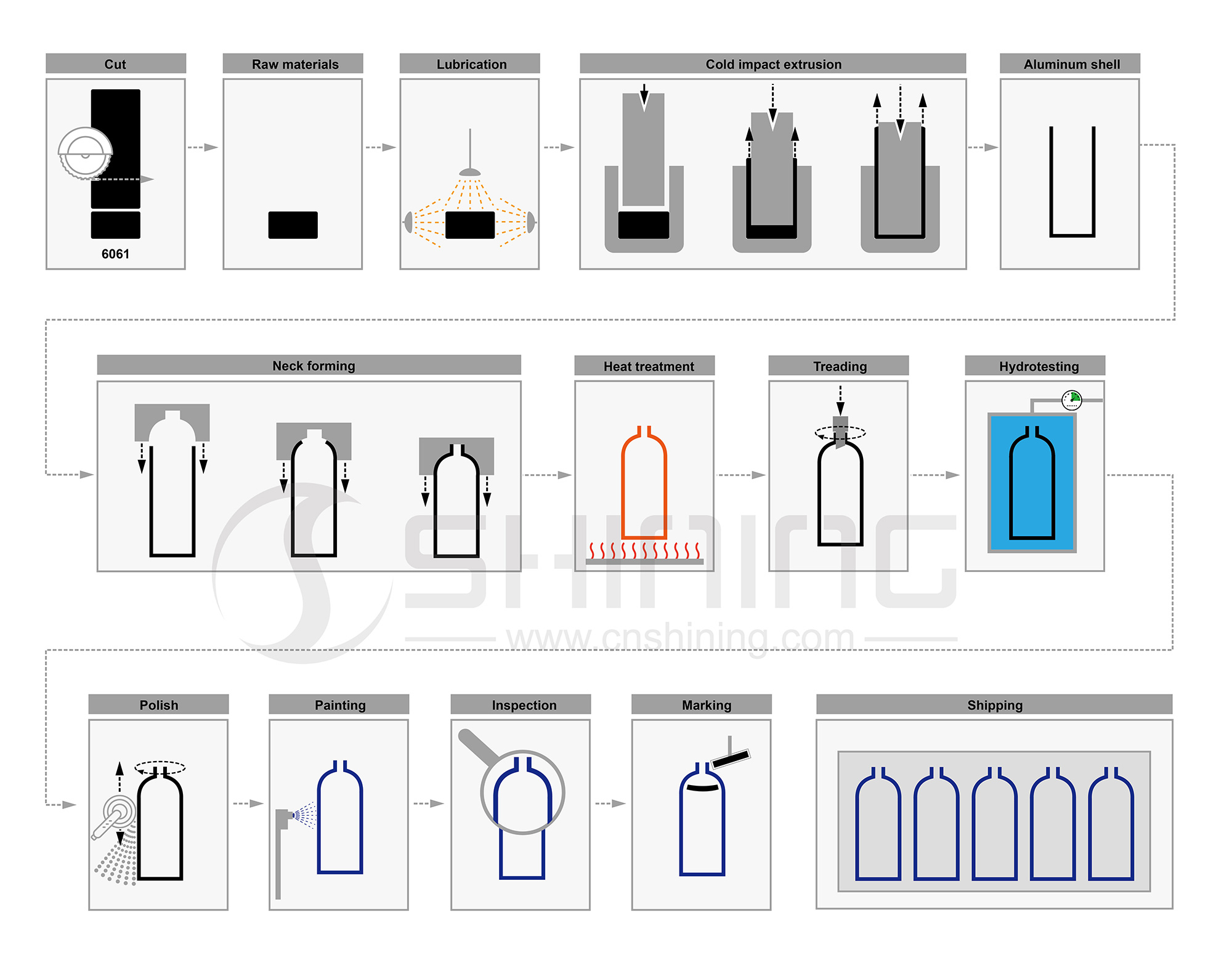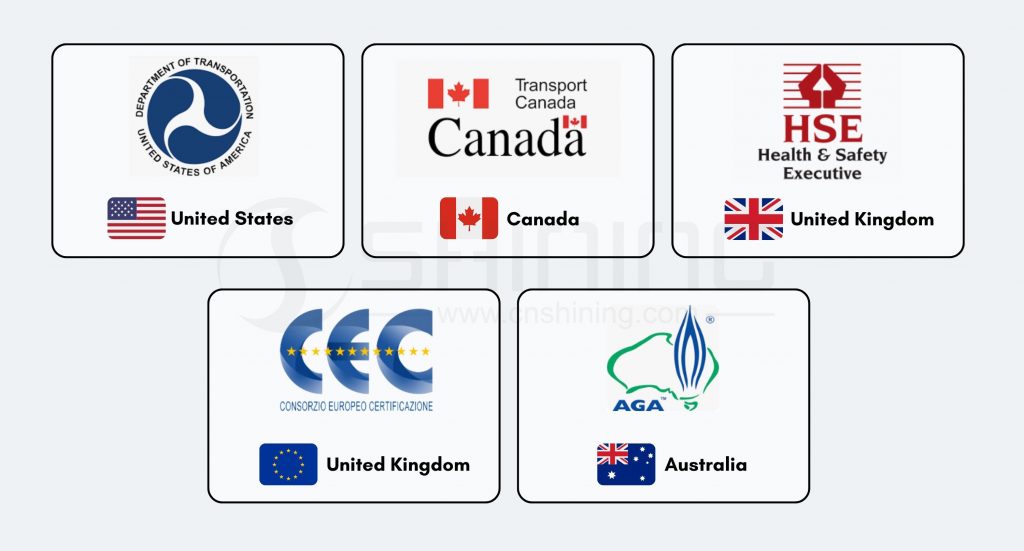Shining Aluminium Packaging — ведущий поставщик газовых баллонов высокого давления в Китае. Мы жертвуем себя на исследования и разработки баллонов с 2001 года, стремясь предоставлять продукцию превосходного качества для индустрии напитков, подводного плавания, медицины, пожарной безопасности и специальных отраслей.
Производитель алюминиевых газовых баллонов
оборудование
Наш контроль качества обеспечивается строгим соответствием международным стандартам, включая ISO, DOT и TPED. Мы оснащены передовым автоматическим оборудованием и производственными системами в соответствии с ISO9001, чтобы соответствовать или превосходить требования и ожидания наших клиентов и международных стандартов.
Отзывы
Поскольку мы очень ценим ваши услуги и очень хорошее качество полиграфической и алюминиевой продукции, мы считаем вас нашим эталонным поставщиком в любом новом проекте, связанном с алюминиевой упаковкой.
Вафаа Халлум Руководитель проекта
Вы были нашим отличным партнером, и мы надеемся, что вы понимаете нашу потребность в дополнительной гибкости в это самое необычное время.
Крис Тоуглавный операционный директор
Предыдущий
Следующий
Находясь в поиске Алюминиевые газовые баллоны?
Полное руководство по алюминиевым газовым баллонам
1. Введение
1.1 Определение алюминиевого газового баллона
Алюминиевый газовый баллон — это контейнер из алюминия 6061, предназначенный для хранения и транспортировки сжатых газов, таких как кислород, азот, гелий и углекислый газ. Эти баллоны обычно используются в различных промышленных и медицинских целях, где требуется портативный и легкий источник сжатого газа.
Алюминиевые газовые баллоны имеют ряд преимуществ по сравнению со стальными баллонами, включая меньший вес, что делает их более портативными, и лучшую коррозионную стойкость, что может помочь продлить срок их службы. Кроме того, алюминиевые баллоны имеют более высокую теплопроводность, что обеспечивает более эффективное рассеивание тепла во время наполнения и выпуска газа. Однако алюминиевые баллоны могут быть дороже стальных из-за более высокой стоимости материалов, используемых при их производстве.
1.2 История алюминиевых газовых баллонов
История алюминиевых газовых баллонов восходит к началу 20 века, когда впервые было обнаружено, что алюминий является подходящим материалом для использования в строительстве сосудов высокого давления. До использования алюминия газовые баллоны обычно изготавливались из стали или железа, которые были тяжелыми и подверженными ржавчине.
В 1920-х годах немецкая компания Mannesmann начала производить алюминиевые газовые баллоны для зарождающейся авиационной промышленности. Первоначально эти баллоны использовались для хранения сжатого воздуха в пневматических системах самолетов. Они были легче своих стальных аналогов, что делало их идеальными для использования в самолетах, где вес был критическим фактором.
Алюминиевые газовые баллоны начали более широко использоваться в 1940-х и 1950-х годах для различных целей, включая сварку, дайвинг и хранение медицинского кислорода. Эти баллоны обычно изготавливались с использованием бесшовного процесса экструзии, который производил легкий, высокопрочный контейнер.
Со временем конструкция алюминиевых газовых баллонов претерпела изменения, улучшились материалы, производственные процессы и стандарты безопасности. Сегодня алюминиевые газовые баллоны используются в различных областях, в том числе в медицине, промышленности и досуге. Они ценятся за свой малый вес, прочность и устойчивость к коррозии и являются важнейшим компонентом во многих современных технологиях.
1.3 Преимущества алюминиевого газового баллона
Использование алюминиевого газового баллона имеет ряд преимуществ, в том числе:
- Легкость: алюминиевые газовые баллоны легче стальных, что упрощает их обработку и транспортировку.
- Устойчивость к коррозии: алюминиевые газовые баллоны устойчивы к коррозии, что делает их более прочными и долговечными.
- Высокая прочность: алюминиевый газ — прочный и долговечный материал, способный выдерживать высокое давление, что делает его идеальным для газовых баллонов.
- Немагнитность: алюминиевый газовый баллон немагнитен, что делает его более безопасным для использования в средах, где существуют проблемы с магнитными полями.
- Высокая чистота газа: алюминиевые газовые баллоны имеют высокий уровень чистоты газа, что имеет важное значение для областей применения, требующих высокого уровня чистоты газа, например, в медицине и научных исследованиях.
- Вторичная переработка: алюминий является материалом, поддающимся вторичной переработке, а переработка алюминия экономит 95% энергии, необходимой для его производства из сырья. Это означает, что алюминиевые газовые баллоны можно перерабатывать многократно, что сокращает отходы и сохраняет природные ресурсы.
2. Конструкция алюминиевого газового баллона
Алюминиевые газовые баллоны обычно изготавливаются из высокопрочных алюминиевых сплавов, которые обеспечивают легкую и прочную конструкцию. Конкретная конструкция баллона может различаться в зависимости от предполагаемого использования, но большинство алюминиевых газовых баллонов имеют схожую базовую конструкцию.
Основными компонентами алюминиевого газового баллона являются:
Корпус цилиндра: Это основная часть цилиндра, которая обычно имеет цилиндрическую форму. Корпус изготовлен из бесшовной экструдированной алюминиевой трубы, рассчитанной на высокое давление. Номинальное давление цилиндра определяет толщину стенок цилиндра.
Кольцо на шею: Это воротник на верхней части корпуса баллона. Горловое кольцо обеспечивает надежную точку крепления клапана и защищает баллон от повреждений во время обработки и транспортировки. Горловые кольца обычно крепятся клепкой, а не резьбой, поскольку резьба уменьшает толщину стенки алюминиевого газового баллона.
Клапан газового баллона: Клапан газового баллона — это устройство, которое управляет потоком газа в газовый баллон и из него. Обычно он изготавливается из латуни или стали и рассчитан на долговечность и устойчивость к высокому давлению. Клапан обычно присоединяется к алюминиевому баллону с помощью резьбового соединения, и его можно открывать и закрывать с помощью колеса или ручки клапана. Клапаны газовых баллонов разработаны так, чтобы быть безопасными и надежными, и обычно имеют некоторые встроенные функции безопасности. Например, многие клапаны имеют устройство сброса давления, которое автоматически выпускает газ, если давление внутри баллона превышает определенный уровень. Это помогает предотвратить взрыв или разрыв баллона.
Защитный колпачок: Защитный колпачок представляет собой пластиковую или металлическую крышку, надеваемую на клапан для защиты его от повреждений и загрязнения, когда баллон не используется.
В целом, конструкция алюминиевого газового баллона направлена на создание прочной, легкой и долговечной конструкции, которая может безопасно содержать газы высокого давления. Конкретные компоненты и характеристики баллона будут зависеть от предполагаемого использования и требований приложения.
3. Маркировка алюминиевых газовых баллонов
Алюминиевые газовые баллоны должны быть маркированы в соответствии с правилами, установленными Министерством транспорта (DOT) и Министерством транспорта Канады (TC). Маркировка предоставляет важную информацию о содержимом баллона, его использовании и безопасности.
Вот некоторые стандартные маркировки, которые вы можете увидеть на алюминиевом газовом баллоне:
ВЕРХНИЙ РЯД: Содержит производственные маркировки, такие как тип резьбы цилиндра, страна изготовления и серийный номер, присвоенный производителем.
- Пригодность для использования под водой «uw», если применимо; только для композитных баллонов!
- Клеймо неразрушающего контроля (если применимо)
- Определяет алюминиевый сплав (если применимо).
- Знак совместимости для газов, вызывающих водородную хрупкость, и газовых смесей «H» (если применимо; только для стальных сосудов под давлением)
- Серийный номер, присвоенный производителем
- Страна производитель
- Определение типа резьбы цилиндра
СРЕДНИЙ РЯД: Содержит эксплуатационные отметки, такие как испытательное давление и фактический или пустой вес. А также минимальную толщину стенки.
- Рабочее давление в барах. Предназначены для баллонов, транспортирующих сжатые газы и ацетилен.
- Испытательное давление в барах
- Масса пустого или тарного груза в килограммах
- Для сжиженных газов емкость по воде
- Минимальная толщина стенки измеряется в миллиметрах
НИЖНИЙ РЯД: Содержит сертификационные знаки, такие как символ упаковки ООН, стандарт ISO, страна или одобрение страны и знак одобрения производителя.
- Упаковочный символ ООН
- Стандарт ISO (например, 9809-1, 9809-2 и т. д.), используемый для проектирования, строительства и испытаний.
- Знак страны или стран, где выдано одобрение, за которым следует знак одобрения производителя. Только сосуды под давлением ООН с маркировкой «USA» разрешены для транспортировки из или в пределах Соединенных Штатов.
- Идентификационный знак или штамп независимого инспекционного агентства.
- Дата первоначальной проверки, год, затем месяц, разделенные косой чертой
4. Типы баллонов высокого давления по материалу
Стальные баллоны, алюминиевые баллоны и композитные баллоны — это различные баллоны высокого давления, используемые для хранения и транспортировки различных газов.
Стальные баллоны являются наиболее распространенным типом газовых баллонов, обычно изготавливаются из бесшовной тянутой углеродистой стали. Они прочны и выдерживают высокое давление, что делает их пригодными для хранения и транспортировки широкого спектра газов. Стальные баллоны также относительно недороги и могут использоваться повторно много раз. Однако они тяжелые и могут быть подвержены коррозии, если не обслуживаются должным образом.
Алюминиевые баллоны являются более легкой альтернативой стальным баллонам. Они изготавливаются из высокопрочных алюминиевых сплавов и более устойчивы к коррозии, чем стальные баллоны. Алюминиевые баллоны также дороже стальных, но их легкий вес и коррозионно-стойкие свойства делают их популярными для определенных применений, таких как подводное плавание и медицинский кислород.
Цилиндр из композитного углеродного волокна использует тонкостенный внутренний цилиндр из алюминиевого сплава и обмотан композитным материалом из углеродного волокна. Они легче стальных и алюминиевых цилиндров и обладают превосходной прочностью и долговечностью. Композитные цилиндры также обладают высокой устойчивостью к коррозии и могут хранить широкий спектр газов, включая кислород, азот и углекислый газ. Однако они дороже как стальных, так и алюминиевых цилиндров.
Подводя итог, можно сказать, что каждый тип цилиндра имеет свои уникальные преимущества и недостатки, а выбор типа зависит от конкретных требований области применения.
5. Цвет алюминиевого газового баллона
Алюминиевые газовые баллоны могут быть разных цветов в зависимости от предполагаемого использования или отрасли. Наиболее распространенным цветом для алюминиевых газовых баллонов является серебристый, естественный цвет металла. Однако производители также могут наносить на баллоны различные цвета с помощью краски или порошкового покрытия для идентификации или в целях безопасности.
Цветовая маркировка газовых баллонов часто стандартизирована в соответствии с отраслевыми стандартами для обеспечения безопасного обращения, хранения и транспортировки. Например, в Соединенных Штатах Ассоциация сжатого газа (CGA) создала систему цветовой маркировки для маркировки плеч газовых баллонов и защитных колпачков клапанов. Эта система использует определенные цвета для обозначения типа газа, его уровня опасности и другой важной информации.
- Серебро: Наиболее распространенный цвет для алюминиевых газовых баллонов — серебристый, естественный цвет металла. Эти баллоны могут использоваться для различных газов и, как правило, не предназначены для какого-либо определенного типа газа.
- Зеленый: Зеленые баллоны часто используются для кислорода. Поскольку кислород жизненно важен для жизни растений, а зеленый цвет ассоциируется с природой и ростом.
- Коричневый: Коричневые баллоны обычно используются для ацетилена, который обычно используется при сварке и резке. Этот цвет также иногда используется для других горючих газов.
- Серый: Серые баллоны часто используются для углекислого газа, который обычно применяется в пищевой промышленности, например, для газирования газированных напитков и пива.
- Синий: Синие баллоны часто используются для закиси азота. Этот цвет также иногда используется для других негорючих газов.
- Красный: Красные баллоны часто используются для огнетушителей, которые содержат сжатые газы, используемые для тушения пожаров. Этот цвет также иногда используется для других типов сжатых газов.
Важно отметить, что цвет баллона может различаться в зависимости от производителя, а система цветовой кодировки, используемая для идентификации газов, может различаться в зависимости от региона или страны. Поэтому всегда важно сверяться с этикеткой баллона или консультироваться с обученным специалистом, чтобы обеспечить правильную идентификацию газовых баллонов.
6. Алюминиевый газовый баллонный клапан, соединительный фитинг, тип адаптера
CGA (Ассоциация по сжатому газу) и DIN (Немецкий институт нормирования) являются двумя стандартами для фитингов для газовых баллонов.
Американский стандарт: CGA
Фитинги CGA широко используются в Северной Америке и идентифицируются по системе номеров (например, CGA 320, CGA 580). Эти фитинги имеют определенные размеры и резьбу, предназначенные для соединения с соответствующим клапаном газового баллона. Некоторые стандартные фитинги CGA включают:
- CGA 320: используется для углекислого газа и других инертных газов
- CGA 580: используется для сжатого воздуха и азота
- CGA 540: используется для кислорода
- CGA 870: используется для медицинского кислорода
- CGA 510: используется для ацетилена
- CGA 590: используется для аргона
- CGA 180: используется для гелия
- CGA 200: используется для азота
- CGA 326: используется для закиси азота
Европейский стандарт: DIN 477
Фитинги DIN широко используются в Европе и идентифицируются по номеру DIN (например, DIN 477-1, DIN 477-5). Эти фитинги также имеют определенные размеры и резьбу, предназначенные для соединения с соответствующим клапаном газового баллона. Некоторые стандартные фитинги DIN включают:
- DIN 477-1: используется для азота и аргона
- DIN 477-5: используется для углекислого газа
- DIN 477-6: используется для кислорода
- DIN 477-7: используется для пропана и бутана
- DIN 477-8: используется для водорода
- DIN 477-9: используется для гелия
- DIN 477-10: используется для ацетилена
Если вам необходимо подключить газовый баллон с фитингом CGA к системе, требующей фитинг DIN (или наоборот), вы можете использовать адаптер фитинга. Адаптеры DIN доступны для различных фитингов CGA, а адаптеры CGA доступны для различных фитингов DIN.
Британский стандарт: BS341
Спецификация британского стандарта для соединений клапанов газовых баллонов BS341 определяет различные типы соединений клапанов, используемых в газовых баллонах. Ниже приведены различные типы соединений, указанные в BS341:
- BS 341 № 2 — это соединение используется для бутана и пропана и также известно как клапан 21,7 мм.
- BS 341 № 3 — это соединение используется для сжиженного нефтяного газа (СНГ) и также известно как 25-миллиметровый клапан.
- BS 341 № 4 — это соединение используется для ацетилена и также известно как клапан 9/16″.
- BS 341 № 6 — это соединение используется для подачи кислорода, также известно как клапан 3/4″.
- BS 341 № 8 — это соединение используется для углекислого газа, также известное как клапан 5/8″.
- BS 341 № 10 — это соединение используется для газообразного азота и также известно как клапан 1 1/8″.
- BS 341 № 13 — это соединение используется для аргона, также известно как клапан 5/8″.
Выходы и соединения клапана цилиндра
Газовые баллоны с клапанами, имеющими выходные соединения стандартов BS, CGA и DIN. В некоторых случаях могут использоваться альтернативные соединения, и по запросу заказчика они будут поставляться вместо стандартов, показанных ниже.
| Газ | БС | CGA | DIN | Газ | БС | CGA | DIN |
| Ацетилен | 2 | 510 | – | Хлороводород | 6 | 330 | 8 |
| Воздух | 3 | 590 | 6 | Сероводород | 15 | 330 | 5 |
| Аллен | – | 510 | 1 | изо-бутан | 4 | 510 | 1 |
| Аммиак безводный | 10 | 240, 660 | 8 | Изо-бутилен | 4 | 510 | 1 |
| Аргон | 3 | 580 | 10 | Криптон | 3 | 580 | 10 |
| Арсин | 4 | 350 | 5 | Метан | 4 | 350 | 1 |
| 1,3-бутадиен | 4 | 510 | 1 | Метилхлорид | 7 | 660 | 5 |
| Бутан | 4 | 510 | 1 | Метилмеркаптан | – | 330 | 5 |
| бутены | 4 | 510 | 1 | Моноэтиламин | 11 | 240 | 5 |
| Углекислый газ | 8 | 320 | 6 | Монометиламин | 11 | 240 | 5 |
| Монооксид углерода | 4 | 350 | 5 | Натуральный газ | 4 | 350 | 1 |
| Карбонилфторид | – | 660 | 8 | Неон | 3 | 580 | 10 |
| Карбонилсульфид | – | 330 | 5 | Оксид азота | 14 | 660 | 8 |
| хлор | 6 | 660 | 8 | Азот | 3 | 580 | 10 |
| Циан | – | 660 | 8 | Двуокись азота | 14 | 660 | 8 |
| Дейтерий | 4 | 350 | 1 | Оксид азота | 13 | 326 | 6 |
| Диметиламин | 11 | 240 | 5 | Кислород | 3 | 540 | – |
| Диметиловый эфир | – | 510 | 1 | Фосген | 6 | 660 | 8 |
| Этан | 4 | 350 | 1 | Фосфин | 4 | 350 | 5 |
| Этиловый ацетилен | – | 510 | 1 | Пропан | 4 | 510 | 1 |
| Этилхлорид | 7 | 510 | 1 | пропилен | 4 | 510 | 1 |
| этилен | 4 | 350 | 1 | силан | – | 350 | 5 |
| Окись этилена | 7 | 510 | 1 | Тетрафторид кремния | – | 330 | 8 |
| Хладон-14 | 6 | 580 | 6 | Диоксид серы | 12 | 660 | 8 |
| Хладон-22 | 6 | 660 | 6 | Гексафторид серы | 6 | 590 | 6 |
| гелий | 3 | 580 | 10 | Триметиламин | 11 | 240 | 5 |
| Водород | 4 | 350 | 1 | Винилхлорид | 7 | 510 | 5 |
| бромистый водород | – | 330 | 8 | ксенон | 3 | 580 | 10 |
| Хлороводород | 6 | 330 | 8 |
7. Производство алюминиевых газовых баллонов
Вот краткий обзор этапов производства алюминиевого газового баллона:
Сырье: Основным сырьем, используемым при производстве алюминиевого газового баллона, является алюминиевая заготовка из сплава 6061. Пробка представляет собой цилиндрический кусок металла, который в конечном итоге образует корпус цилиндра.
Смазка: Заготовка смазывается для уменьшения трения в процессе производства. Это помогает предотвратить прилипание заготовок к матрице во время экструзии.
Холодно-ударная экструзия: Затем смазанную заготовку помещают в пресс-форму и подвергают холодной ударной экструзии. Этот процесс включает сжатие пробки под высоким давлением с образованием цилиндрической оболочки.
Формирование шеи: После того, как оболочка сформирована, верхний конец формуется и формируется для создания горловины, к которой будет прикреплен клапан.
Термическая обработка: Затем оболочка подвергается термической обработке, которая включает закалку для повышения ее прочности и твердости. Затем оболочка выдерживается в печи для обработки раствором Т6 для получения желаемой прочности и долговечности.
Шаг: Корпус имеет резьбу на верхнем конце для возможности крепления клапана.
Гидроиспытания: Затем цилиндр подвергают гидростатическим испытаниям, во время которых он наполняется водой и находится под давлением, чтобы убедиться, что он может выдержать требуемое давление.
польский: Затем цилиндр полируется, чтобы удалить любые дефекты поверхности и создать гладкую поверхность.
Рисование: Цилиндр окрашен прочным покрытием, чтобы защитить его от коррозии и сделать его более привлекательным.
Осмотр: Цилиндр проверяется на соответствие всем требуемым спецификациям и стандартам.
Маркировка: Цилиндр маркируется различными кодами, включая название производителя, серийный номер и другие идентификационные знаки.
Перевозки: Наконец, баллоны упаковываются и отправляются заказчикам, которые их заказали.
Это общий обзор производственного процесса, а конкретные детали могут различаться в зависимости от производителя и предполагаемого использования баллона.
8. Испытания и сертификация газовых баллонов
Испытания и сертификация алюминиевых газовых баллонов различаются в зависимости от страны, поскольку в каждой стране действуют свои правила и стандарты. Вот несколько примеров испытаний и сертификации алюминиевых газовых баллонов в разных странах:
Соединенные Штаты: В Соединенных Штатах алюминиевые газовые баллоны регулируются Министерством транспорта (DOT). Баллоны должны проверяться и сертифицироваться уполномоченным DOT учреждением каждые 5 лет с использованием специальных методов, включая гидростатические и ультразвуковые испытания. Баллоны также должны иметь специальную маркировку, включая маркировку спецификации DOT, название и адрес производителя, а также серийный номер баллона.
Канада: В Канаде алюминиевые газовые баллоны регулируются Министерством транспорта Канады. Баллоны должны проверяться и сертифицироваться каждые 10 лет на объекте, утвержденном TC, с использованием специальных методов испытаний, включая гидростатические испытания и визуальный осмотр. Баллоны также должны иметь специальную маркировку, в том числе маркировку спецификации TC, название и адрес производителя, а также серийный номер баллона.
Великобритания: В Соединенном Королевстве алюминиевые газовые баллоны регулируются Управлением по охране труда и технике безопасности (HSE). Баллоны должны проходить испытания и сертификацию каждые 5 или 10 лет, в зависимости от их использования, на предприятии, имеющем сертификат HSE, с использованием специальных методов испытаний, включая гидростатические испытания и визуальный осмотр. Баллоны также должны иметь специальную маркировку, включая маркировку спецификации EN, название и адрес производителя, а также серийный номер баллона.
Евросоюз: В Европейском союзе алюминиевые газовые баллоны должны соответствовать Директиве по оборудованию, работающему под давлением (PED), и Директиве по переносному оборудованию, работающему под давлением (TPED). Эти директивы обеспечивают основу для испытаний и сертификации газовых баллонов, в том числе алюминиевых баллонов. Баллоны должны проверяться и сертифицироваться уполномоченным органом каждые 10 лет с использованием специальных методов испытаний, включая гидростатические испытания и ультразвуковые испытания. Баллоны также должны иметь специальную маркировку, включая маркировку СЕ, наименование и адрес производителя, а также серийный номер баллона.
Австралия: В Австралии алюминиевые газовые баллоны регулируются Австралийской газовой ассоциацией (AGA). Баллоны должны тестироваться и сертифицироваться каждые 10 лет на объекте, утвержденном AGA, с использованием специальных методов испытаний, включая гидростатические испытания и визуальный осмотр. Баллоны также должны иметь специальную маркировку, включая маркировку спецификации AGA, название и адрес производителя, а также серийный номер баллона.
Важно отметить, что эти правила и стандарты могут меняться со временем и могут варьироваться в зависимости от типа газового баллона и его предполагаемого использования. Поэтому всегда лучше проконсультироваться с квалифицированным специалистом или регулирующим органом, чтобы убедиться, что ваш алюминиевый газовый баллон соответствует требованиям тестирования и сертификации, принятым в вашей стране.
9. Применение алюминиевого газового баллона
Существует несколько типов алюминиевых газовых баллонов, используемых для различных целей:
- Баллоны SCBA (автономный дыхательный аппарат): эти алюминиевые газовые баллоны используются пожарными, спасателями и промышленными рабочими, которым необходима защита органов дыхания в опасных условиях.
- Промышленные и сварочные баллоны: Эти алюминиевые газовые баллоны используются в таких отраслях, как производство, строительство и металлообработка для сварки, резки и других промышленных процессов.
- Медицинские баллоны: Эти алюминиевые газовые баллоны используются в медицинских учреждениях для хранения и транспортировки медицинских газов, таких как кислород, азот и гелий.
- Баллоны огнетушителей: Эти алюминиевые газовые баллоны используются в огнетушителях для хранения сжатых газов, таких как двуокись углерода или азот.
- Цилиндры для напитков: Эти алюминиевые газовые баллоны используются в производстве напитков для хранения и дозирования углекислого газа для газирования безалкогольных напитков, пива и других напитков.
- Альтернативные топливные цилиндры: Эти алюминиевые газовые баллоны хранят сжатый природный газ (CNG) или сжиженный нефтяной газ (LPG) в качестве альтернативного топлива в транспортных средствах.
- Специальные газовые баллоны: Эти алюминиевые газовые баллоны используются для хранения и транспортировки специальных газов, таких как калибровочные газы, инертные газы и газы высокой чистоты, используемые в исследованиях, производстве и других специализированных приложениях.
- Инфляционные и аэрокосмические баллоны: Эти алюминиевые газовые баллоны используются в аэрокосмической промышленности для надувания аварийных трапов самолетов, плотов и спасательных жилетов.
- Высокопроизводительные гоночные цилиндры: Эти алюминиевые газовые баллоны используются в гоночных гонках для хранения и дозирования закиси азота для наддува двигателя.
- Пробоотборные цилиндры: Эти алюминиевые газовые баллоны используются в мониторинге окружающей среды, анализе газа и других научных приложениях для хранения и транспортировки проб газа для анализа.
- Баллоны с закисью азота: Алюминиевый газовый баллон для закиси азота используется для хранения и транспортировки закиси азота. Закись азота — это бесцветный газ со сладким запахом, обычно используемый в качестве мягкого анестетика и анальгетика в медицинских и стоматологических учреждениях. Он также используется в пищевой промышленности в качестве пропеллента для взбитых сливок и в автомобильной промышленности в качестве добавки для повышения производительности гоночных автомобилей.
10. Меры предосторожности для алюминиевого газового баллона
Ниже приведены некоторые важные меры предосторожности, которые необходимо соблюдать при обращении и использовании алюминиевых газовых баллонов:
10.1 Надлежащее обращение и хранение:
- Всегда держите цилиндр вертикально, чтобы предотвратить его опрокидывание.
- Используйте подходящую тележку или тележку для перемещения цилиндра и избегайте волочения его по полу.
- Надлежащим образом закрепите цилиндр, когда он не используется, чтобы предотвратить его падение или опрокидывание.
- Не поднимайте баллон за клапан или регулятор.
10.2 Регулярный осмотр и техническое обслуживание:
- Регулярно проверяйте цилиндр квалифицированным техническим специалистом, чтобы убедиться, что он в хорошем состоянии.
- Замените цилиндр, если на нем есть признаки повреждения, такие как вмятины, трещины или коррозия.
- Замените клапан или регулятор, если они повреждены или имеют признаки износа.
10.3 Избегайте воздействия экстремальных температур:
- Держите цилиндр вдали от источников тепла, пламени или искр.
- Не подвергайте баллон воздействию температур выше 130°F (54°C) или ниже -40°F (-40°C).
- Храните баллон в прохладном, сухом месте вдали от прямых солнечных лучей.
Соблюдая эти меры предосторожности, вы можете помочь предотвратить несчастные случаи и обеспечить безопасное обращение и использование алюминиевых газовых баллонов.
11. Китайский производитель алюминиевых газовых баллонов
Если вам нужны высококачественные алюминиевые газовые баллоны, подумайте о том, чтобы обратиться к известному производителю в Китае, например к Shining Aluminium Packaging. У нас есть проверенный опыт производства надежных и долговечных алюминиевых газовых баллонов для различных применений.
Не стесняйтесь обращаться к нам за дополнительной информацией или запросить цитату. Благодаря их опыту и приверженности качеству мы можем предоставить вам правильные решения для ваших конкретных потребностей.
12. Часто задаваемые вопросы
Алюминиевые баллоны используются для хранения и транспортировки сжатых газов, таких как кислород, азот и углекислый газ. Они часто используются в промышленных, медицинских и лабораторных условиях.
Алюминиевые баллоны должны соответствовать строгим стандартам безопасности и регулярно проверяться и тестироваться. Найдите на баллоне маркировку, указывающую на то, что он был протестирован и сертифицирован, и проверьте дату истечения срока годности, чтобы убедиться, что срок его службы еще не истек.
Алюминиевые баллоны следует хранить в прохладном, сухом и хорошо проветриваемом помещении, вдали от источников тепла, пламени или воспламенения. Их следует хранить в вертикальном положении и закреплять в устойчивом положении, чтобы предотвратить падение.
Да, алюминиевые баллоны можно заправлять соответствующим газом или смесью газов, если они были надлежащим образом испытаны и сертифицированы. Всегда следуйте инструкциям производителя и используйте соответствующее заправочное оборудование.
Алюминиевые баллоны следует перевозить в безопасном вертикальном положении и закреплять, чтобы предотвратить их перемещение или падение во время транспортировки. Кроме того, их следует транспортировать в хорошо проветриваемом помещении и вдали от источников тепла, пламени или воспламенения.
Да, алюминиевые баллоны могут быть переработаны. Обратитесь в местное предприятие по переработке, чтобы узнать, как правильно утилизировать алюминиевый баллон.
Алюминиевые баллоны могут быть опасны при неправильном обращении. Они могут взорваться при воздействии высокой температуры или пламени, а также при повреждении или повреждении. Всегда соблюдайте правила техники безопасности при работе с алюминиевыми баллонами и немедленно обращайтесь за медицинской помощью, если вы подверглись воздействию сжатого газа или алюминиевый баллон поврежден.
Манометр на клапане баллона может показать, сколько там осталось газа. Однако важно отметить, что манометр показывает только давление газа, а не количество газа, оставшегося в баллоне. Поэтому для точного определения количества оставшегося газа может потребоваться взвешивание баллона.
Алюминиевые баллоны можно использовать для подводного плавания, но они должны быть специально разработаны и сертифицированы. Они также должны быть заполнены соответствующей газовой смесью для дайвинга, такой как воздух, найтрокс или тримикс.
Если алюминиевый баллон поврежден или дает течь, его следует немедленно вывести из эксплуатации и доставить в квалифицированный центр проверки баллонов для осмотра и ремонта. Не пытайтесь ремонтировать или использовать поврежденный цилиндр.
Алюминиевые баллоны можно красить или покрывать, но важно использовать соответствующую краску или покрытие, совместимые с газом, хранящимся в баллоне. Обратитесь за рекомендациями к производителю или квалифицированному инспектору по баллонам.
Алюминиевые баллоны следует проверять и испытывать через регулярные промежутки времени, указанные производителем и регулирующими органами. Обычно это включает в себя визуальный осмотр и гидростатические испытания, которые проверяют способность цилиндра безопасно выдерживать давление. Интервалы проверок и испытаний зависят от типа баллона и его предполагаемого использования.
Алюминиевые баллоны можно использовать для хранения пищевых газов, таких как углекислый газ, для газирования напитков. Однако баллон должен быть специально разработан и сертифицирован для такого использования, а газ должен быть сертифицирован как пищевой.
Алюминиевые баллоны можно использовать для хранения медицинского кислорода, но они должны быть разработаны и сертифицированы для этого использования. Кроме того, цилиндр необходимо очистить и продезинфицировать перед использованием, чтобы предотвратить загрязнение.
Не рекомендуется использовать алюминиевые баллоны для хранения агрессивных газов, так как алюминий может вступать в реакцию с некоторыми агрессивными газами, в результате чего баллон становится нестабильным или даже взрывается. Вместо этого проконсультируйтесь с изготовителем или квалифицированным инспектором по баллонам для получения рекомендаций по соответствующему материалу баллона для хранения коррозионно-активных газов.

















